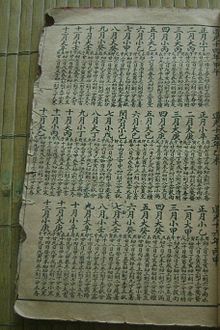Kalendarz Chiński

Chińczycy również bardzo wcześnie stworzyli kalendarz. Wiemy, że już w III tysiącleciu p.n.e. prowadzili oni obserwacje astronomiczne. Niektórzy przypuszczają, że nawet 17—18 tysięcy lat wcześniej. Z pewnością — przesada. Ale wiadomo, że jeszcze do 1280 r. n.e. Chińczycy używali kalendarza, w którym lata liczono od pewnej daty odległej o… 143 000 lat!
Nie ma powodu wątpić, że kultura chińska jest jedną z najstarszych, a może nawet najstarszą. Jednak źródła, na podstawie których ustalono domniemany wiek chińskiej astronomii, są tak niejasne i sprzeczne, że trudno się na nich opierać.
Zawinił tu w dużym stopniu cesarz Czeng (III w. p.n.e.), który zwyciężywszy innych książąt rozbitego wówczas cesarstwa wsławił się niechlubnie tym, że kazał spalić wszystkie biblioteki. Szy-Huang-Ti, czyli Pierwszy Żółty Cesarz (taki przyjął tytuł), pragnął, aby naród zapomniał o przeszłości, a historia Chin rozpoczęła się od jego panowania. Rozkaz władcy wypełniono z bezwzględnym posłuszeństwem. Wprawdzie po jego śmierci historycy i pisarze zaczęli odtwarzać spalone dzieła, ale… któż byłby w stanie zapamiętać wszystkie? Poplątano więc ile wlezie. Pierwotny, znany nam kalendarz chiński oparty był na rachubie księżycowej. Powstał przypuszczalnie w 2637 r. p.n.e. (ten właśnie rok przyjęto za początek nowej ery kalendarzowej). Składał się z 12 miesięcy 29- i 30-dniowych. Chiński rok liczył więc 354 dni.
Dla wyrównania rozbieżności z rokiem zwrotnikowym — dodawano 7 razy w ciągu 19-letniego cyklu trzynasty miesiąc.
Z czasem Chińczycy obliczyli, że rok ma 365,5 dnia. Wówczas przeprowadzono reformę. Nowy kalendarz miał charakter księżycowo-słoneczny i składał się z 12 miesięcy 30- i 31-dniowych (na przemian). Rok chiński miał więc 366 dni.
Początek roku przypadał między 21 I a 19 II (według naszej rachuby czasu). Miesiące nie miały nazw. Oznaczano je numerami. Dzieliły się na dekady. Ustaleniem początku roku, który w Chinach obchodzono bardzo uroczyście przez kilka dni, zajmowali się specjaliści. Ich ustalenia zatwierdzał Syn Nieba, cesarz. Przez wiele stuleci kalendarz opracowywany był przez specjalne biuro astronomii, którego dyrektor, piastujący godność ministra, co roku przedkładał nowy kalendarz cesarzowi do zatwierdzenia. Po zatwierdzeniu — egzemplarze kalendarza wręczano najwyższym dostojnikom cesarstwa według skrupulatnie ustalanej listy. Otrzymywanie kalendarza było bowiem wyrazem szczególnej łaski.
Niektóre dynastie za początek roku przyjmowały inny miesiąc, niekiedy czyniły to także zbuntowane prowincje, chcąc w ten sposób zaznaczyć swą niezależność. Na ogół jednak nowy rok przypadał w styczniu lub lutym.
W 163 r. p.n.e. 366-dniowy kalendarz został zreformowany. Dzieła tego dokonał Sy-ma T’sien, noszący zaszczytny tytuł Wielkiego Księcia Astrologa. Dostosował on dotychczasowy kalendarz do roku słonecznego, dzięki czemu chińska rachuba czasu w zasadzie nie odbiegała od słonecznej. Cesarz Wen nakazał też, by ów rok (163 p.n.e.) uznano za początek nowej ery. W I w. n.e. wprowadzono również kalendarz posługujący się cyklem 60-letnim. Ogłosił go Syn Nieba z dynastii Hia w Ming-t’angu, czyli Domu Kalendarza, w 105 r. Za początek ery przyjęto 2637 p.n.e. Dla oznaczenia poszczególnych lat stosowano zestawienia znaków cyklicznych, należących do dwóch grup: tzw. t’ien-kan, czyli „niebiańskich płci” oraz ti-czy, czyli „ziemskich gałęzi”. Pierwsza z tych grup składała się z 10 znaków, druga — z 12. Zestawiano kolejny pierwszy znak t’ien-kan z pierwszym znakiem ti-czy, pierwszy znak t’ien-kan z jedenastym znakiem ti-czy, itd. Po pięciokrotnym powtórzeniu grupy znaków ti-czy otrzymywano 60-letni cykl mierzenia czasu.
